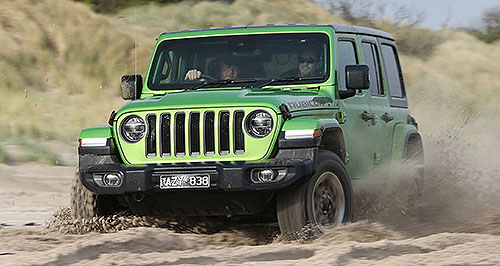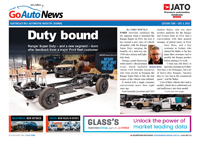Make / Model Search
News - JeepJeep on the comeback trailFewer buyback and warranty claims plus a richer sales mix underpin Jeep’s revival28 May 2019 JEEP brand head of Asia-Pacific and Fiat Chrysler Automobiles (FCA) Australia president and CEO Steve Zanlunghi has pointed to significantly lower vehicle buyback rates and falling warranty claims as evidence that its all-important, volume-selling US off-road brand is ready to emerge from the wilderness.
Jeep sales have fallen off a cliff in recent years, from a height of more than 30,000 in 2014 to just 7326 new registrations last year, compounded further this year with a 27.5 per cent fall – to 1791 units – after the first four months of trading.
But the senior management team at FCA Australia has not been sitting idle, implementing a wide range of customer-focused initiatives over the past two years – and planning more, including cheaper servicing – to improve relations with current owners, and draw more people back to the fold, as new models arrive to help arrest the decline and take the brand to profitable, and sustainable, higher levels.
In an interview with GoAuto at this month’s launch of one of these key new models – the fully redesigned JL-series Wrangler – Mr Zanlunghi said the number of defective vehicles his company had to buy back dropped by more than half last year compared to 2017, while warranty claims tumbled by 35 per cent over the same period.
These results stem from a number of changes implemented in 2017 designed to improve Jeep’s battered image after a series of widely publicised cases involving dissatisfied customers. Among the initiatives were warranty and roadside assistance extensions, a doubling of service intervals (to 12 months), improved servicing and better dealer training.
The company has, however, received another setback this week with the Australasian New Car Assessment Program (ANCAP) handing down a disappointing one-star safety rating for the new Wrangler – well below the five-star result that most manufacturers now achieve for their latest vehicles.
“We’ve done a lot of things in the background to deliver on that promise,” Mr Zanlunghi said.
“We’ve launched the five-year warranty and lifetime roadside assist, we’ve done a lot of things on our back end as well, we’ve worked with our teams in Detroit and around the globe on the Jeep side (the Compass comes from India and the Renegade from Europe), and we’ve worked with our engineers about the quality of the vehicles we have arriving in Australia.
“Our warranty rates (were) down significantly last year compared to 2017, and vehicle quality buybacks were down dramatically – a massive per cent year-on-year.
“It’s an over-arching thing. We’re also training our network a lot more with our technicians, and that’s been a big focus for us to make sure the vehicles are fixed the first time.
“So, it’s not just one silver bullet, it’s all these different ingredients that is going into the quality of the vehicle, but we are seeing indications we are massively making strides in the marketplace.”
While Mr Zanlunghi admitted he was disappointed with Jeep’s current sales performance, coming on top of an 11.4 per cent fall last year, he said other factors outside of his control were also to blame.
“A big portion of what we’re seeing with the sales decline has to do with the Australian/US dollar effects,” he said.
“We’re at a two-and-a-half-year low, and if that drops to 68 cents (to the US dollar) then it’ll be at a 10-year historical low, and FCA and the Jeep brand in particular are the most impacted by the US dollar strengthening and the Aussie dollar declining because the other manufacturers don’t have manufacturing bases in the US or NAFTA (North American Free Trade Agreement) as much as we do.
“So, a lot of that has a lot to do with it, because it obviously puts you into a competitive disadvantage when you have to price your vehicles at a little bit of a premium.”
An upshot of the forced higher pricing are richer sales mixes throughout the whole Jeep range, which is one way of improving profitability.
“We started a strategy of going premium with the brand, and we’re seeing that work,” Mr Zanlunghi said.
“At the beginning of 2017, the average net transaction price for Jeep was $38,000. Now, in Q1 2019, it’s $52,000, so we’re really seeing the customers step up to the upper ends of our product line-up, and we’re seeing the mix shift.
“For example, on our Grand Cherokee flagship and bestseller, 65 per cent sold were the Laredo base and now we’re seeing a flip where 65 per cent are the Limited Overland SRT and now also Trackhawk. We started seeing that happen in the middle of 2018, and carrying it into 2019.
“Our bestseller in our Compass line-up is the Limited as well, and we didn’t forecast that … we forecast it to be the lower end of the range with the Sport and Longitude. Same with Cherokee, which was even more dramatic, which used to be 60 per cent Sport and Longitude and now it’s 80 per cent Limited and Trailhawk since we launched last October.”
Mr Zanlunghi is confident a new capped-price servicing (CPS) scheme introduced with the new Wrangler will also help the Jeep’s sales recovery, along with more product releases, other new customer service action and forecasts that the exchange rate situation will improve.
“I think in the back half of this year we’ll see a (sales) increase,” he said. “We’re forecasting the Aussie dollar to get stronger against the US dollar, and we’ve got a few other things we’re working on to drive those sales as well.
“We have special editions, but it’s not just that – it’s the things we’ve been working on behind the scenes, with the customer experience and satisfaction, and also some things we’re working on with our dealer network.
“A pretty big deal for us is the CPS at such low levels, where dealers now can be really hyper-competitive versus the aftermarkets, so that will keep customers coming back to our showrooms, and the more touchpoints you get with your customers, the higher the loyalty percentage.
“It’s starting with the JL (Wrangler), this is a pilot, and then we’ll move forward from there.
“We can spread it to the existing range. We worked really hard with our dealer council to put this together, and it’s a model that’s used by two other OEMs here, and we really looked at doing it because we desperately want this because we want customers to come back to our showrooms and our service departments with all the foundations that we have laid.”
Finding out, and acting upon, why Jeep was losing so many sales was Mr Zanlunghi’s top priority when he began his role as FCA Australia boss in August 2016.
“We’ve been good at identifying things that aren’t right,” he said. “You know, if the baby’s ugly we’ve called it ugly, and we’ve tried to fix it. There’s no sense sticking our head in the sand, and we try to address these issues the best we can. Our management team were pretty open and honest with each other, and if something’s not right, we lay it out on the table and try and fix it.”
Underscoring vehicle quality and customer service improvements have been changes to distribution as well as dealer sales processes.
“It’s been a lot of looking at different areas … (such as) direct haul shipping to Sydney and Brisbane out of our warehouse (in Melbourne), that was a big one because previously we were putting parts on a train, shipping them up to the depot, where they were taken and sorted, and then trucked out to the individual dealers,” he said.
“Now we’re just shipping them directly to dealers out of our warehouse in Melbourne.
“The other thing we did was at the beginning of 2018 we launched what we call ‘qualitative standards’ where dealers basically were measured on how well they take care of customers and certain sales processes that they’re following.”
Mr Zanlunghi also said the job is far from over, with plenty more hard work required to raise the Jeep brand experience up to acceptable levels.
“We have a few other things in the works that I can’t tell you right now to really lift the network and to also assist the dealers in lifting their performances as well,” he said.
“We’re constantly evolving, so we’re constantly just attacking the pieces we see that are just hanging out there, to focus on the customer experience.”  Read more24th of May 2019  Driven: Australian Jeep Wrangler ‘safer’ than EuroV6 and driver-assist tech set to boost ANCAP rating beyond one-star Euro NCAP result4th of September 2018  Jeep primed for sales growth returnFresh product, stronger aftersales support to spur Jeep’s sales turnaround29th of August 2018  Jeep defends high number of product recallsNew-gen Jeep Cherokee recalled before hitting showrooms due to brake fault9th of February 2018  Zanlunghi to lead Jeep brand in regionFCA Australia chief adds responsibility for Jeep brand across Asia-Pacific region |
Click to shareJeep articlesResearch Jeep Motor industry news |











Facebook Twitter Instagram